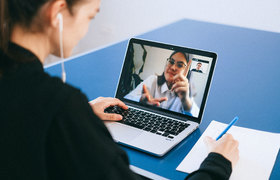TLC2020: design thinking during a pandemic
23 September 2020 | Story Niémah Davids. Photo Getty Images. Read time 5 min.
If you’ve signed up for a course at the University of Cape Town’s (UCT) Hasso Plattner School of Design Thinking (d-school), then you’re familiar with the classroom set-up. White boards line the walls and the conventional in-class seating arrangement has been replaced with high tables and chairs. Teamwork is the norm, and the energy in the room is palpable.
The three p’s essential to design thinking are people (collaboration among teammates), process and place. But as the COVID-19 pandemic hit South Africa, the d-school, like other institutions of learning in the country, was forced to reinvent their courses and their set-up.
On Tuesday, 22 September – day three of UCT’s virtual Teaching and Learning Conference – the d-school’s Luke Doman and Mark Jackson shared how they’ve managed to navigate the online teaching and learning space – this while kicking off the Introduction to Design Thinking course aimed at third-year mechanical engineering students at UCT.
What is design thinking?
Design thinking is an approach to understanding and solving complex problems. The concept is rooted in people, in place and in a process that unlocks the insights and creative collaboration needed to generate innovation.
Before kick-starting their first digital Introduction to Design Thinking course, the team gave themselves a design-thinking challenge, framed around several questions:
- How might we ensure we create the same experience for learners with different access to resources?
- How might we create a design-thinking experience in which WhatsApp becomes the key tool – not just for communication but for learning as well?
- How might we ensure that the data requirement is as low as possible?
- How might we make students feel like what they’re doing is real, even though they’re trapped at home?
- How might we make it possible for participants to experience design thinking while being a slob on the couch?
- How might we ensure that people feel connected to each other even though they’re isolated?
High-level decisions
Successfully executing a design-thinking course with students participating from the confines of their homes would take work. The course requires participants to solve real-world challenges, normally framed around the United Nations’ (UN) Sustainable Development Goals. Facilitators scaled these high-level challenges down and connected them to the home environment. This meant that students still needed to address a UN Sustainable Development Goal but on a much smaller level.
“Everything needed to be scaled to fit a phone.”
The team used Vula as a resource-accessing platform and made WhatsApp its digital platform of choice for projects and team engagement. Using a simplified design-thinking approach, which included the use of templates for easy access on mobile phones, formed part of the new strategy.
“Everything needed to be scaled to fit on a phone. It couldn’t be in PDF format. We worked entirely with JPEGs, something any photo viewer on a phone can edit. At the end, the whole course came in at just 1 MB,” Jackson said.
Participants were split into groups on WhatsApp, and group coaches, who would otherwise have been d-school facilitators, led sessions and supported team members. Students received content regularly and worked asynchronously, only checking in with each other to discuss or synthesise material.
Goals
For this cohort of students, the teams worked towards achieving the following goals for the duration of the course:
- Pushing technology as an enabler, not a barrier – by using technology, participants were easily accessible most times.
- Maintaining the prototyping concept and physical activity to assist with moving in and out of the digital world – this process aimed to replicate the school’s hands-on approach to learning even while teams were disconnected.
- Encouraging students to explore and make use of alternative tools, aside from WhatsApp and Vula – this was done to help understand what suited them and what didn’t.
“We also needed to simplify our language. This meant we used a lot of abstract terminology and metaphors to describe things,” Jackson said.
End result
The coaches were “very impressed” with the students’ prototypes, which indicated that teams managed to engage with and understand the content provided.
“Students were 100% engaged. The move to asynchronous learning gave them the opportunity to think carefully about their projects.”
Students used emojis to express themselves and even took content offline – editing images on a computer when necessary and delivering them via WhatsApp. Some of the hand-built prototypes that students developed included playdough-infused cleaning material to encourage children to wash their hands and a Spider Man-inspired hand-sanitiser device.
Students were 100% engaged. The move to asynchronous learning gave them the opportunity to think carefully about their projects, which improved the quality of their work. The school successfully retained the connection to solving real-world challenges during this course.
“There are many things we are looking forward to. Right now, we are working on how we can simplify this process by creating a nice, low-bandwidth set-up using tools like [these],” Jackson said.
 This work is licensed under a Creative Commons Attribution-NoDerivatives 4.0 International License.
This work is licensed under a Creative Commons Attribution-NoDerivatives 4.0 International License.
Please view the republishing articles page for more information.










